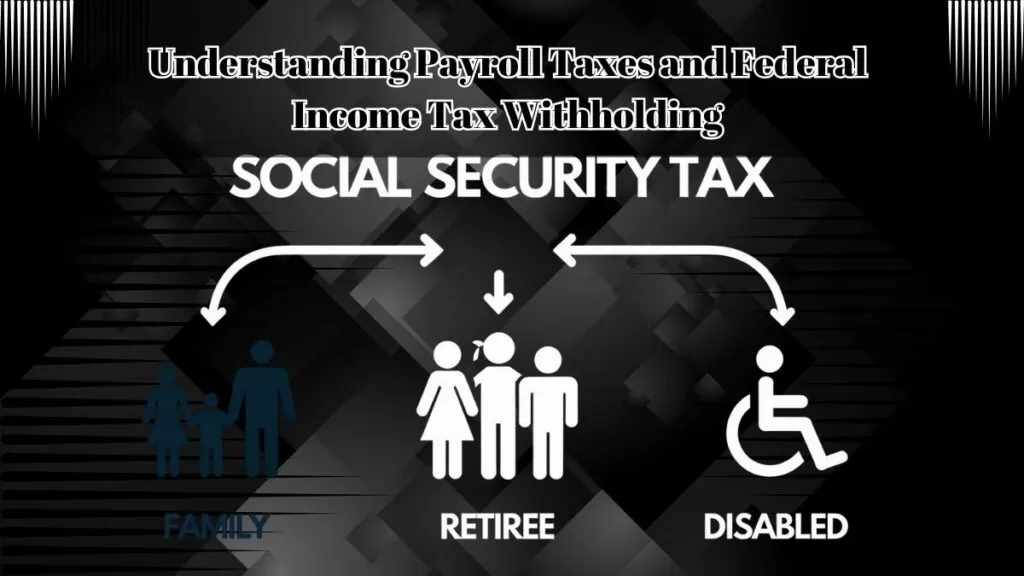Introduction: Understanding Payroll Taxes and Federal Income Tax Withholding
Payroll Taxes: For both employees and payroll managers, a clear understanding of payroll taxes and mandatory government withholding is essential. Workers benefit by knowing how much is taken out of each paycheck for taxes, while managers are responsible for making sure the correct amounts are withheld and submitted to the government.
This guide dives into payroll taxes, federal income tax withholding, and the important role of Form W‑4 in determining how much tax to deduct. Through real-world examples, you’ll see how withholding is calculated and how employers deposit it with the federal government.
Key Aspects of Payroll Taxes

Payroll taxes are vital to funding federal programs like Social Security and Medicare. These taxes are withheld directly from an employee’s paycheck and sent to the government by the employer. Here’s what employees and employers need to know about payroll taxes:
Social Security Tax: What It Funds and How It Works
The Social Security tax, commonly called the FICA tax, benefits employees and their dependents. These include:

- Retirement Benefits: Monthly benefits for retired workers and their families.
- Benefits for Dependents: Payments for the dependents of retired workers.
- Disability Benefits: Payments for disabled workers and their families.
In 2025, the Social Security tax rate for employees will be 6.2%; employers must match this amount. For instance, if an employee’s gross pay is $1,000, their contribution to Social Security will be $62.
Medicare Tax: Health Benefits for the 65+
Medicare taxes help provide health care for older Americans. These taxes are crucial for:

- Medical Benefits: Available for workers, retirees, and spouses who are 65 or older.
The Medicare tax rate is 1.45%, which the employer also matches. On a $1,000 salary, the Medicare tax deduction would be $14.50.
Federal Income Taxes: Funding National Programs
Federal income taxes go towards various essential programs, including:

- National Defense & Law Enforcement: Protecting the country and maintaining justice.
- Social Programs: Aid for low-income individuals, veterans, and others.
- Infrastructure & Development: Funding roads, schools, and community development.
- Interest on the National Debt: Part of the federal budget is allocated to paying off interest on the national debt.
Breakdown of Employee Payroll Taxes: Gross vs. Net Pay
Understanding the difference between Gross pay and Net pay is essential:

- Gross Pay: The total amount an employee earns before deductions.
- Net Pay: The amount the employee takes home after payroll taxes and other deductions.
Example: Angela’s Paycheck Breakdown
If Angela Viviano wins a net compensation of $2,000, here’s how her paycheck breaks down:
Item Amount
Gross Pay $2,000
Social Security Tax (6.2%) -$124
Medicare Tax (1.45%) -$29
Federal Income Tax (Form W-4) -$237
Retirement Fund -$50
Net pay $1,560
In this case, Angela’s employer sends $390 in payroll taxes ($124 + $29 + $237) to the federal government and $50 to her retirement fund.
Federal Income Tax Withholding: How It Works
Also Read – 2025 Tax Law Changes: Key Insights and How to Stay Informed- What You Need to Know

Federal income tax withholding is a key part of financial preparation. It is where employees fill out Form W-4, which guides managers on how much federal income tax to withhold based on different variables, including:
- Filing Status: Single, married, or head of household.
- Number of Dependents: The more dependents an employee claims, the lower the withholding.
- Additional Adjustments: Employees may have extra income or deductions influencing the amount withheld.
Form W-4: An Example of How It Works
Must Read before you file – Master the New Form W-4: Guide to Perfect Tax Withholding

Let’s consider Alicia Myers. She is single and has no dependents, so her Form W-4 would indicate a higher withholding amount than someone claiming dependents. The employer uses this information to determine how much income tax should be deducted from Alicia’s paycheck.
Example of Federal Income Tax Withholding
If Alicia’s gross pay is $2,000, her income tax withholding (calculated based on her W-4 and current tax brackets) might be $237, as shown in the comprehensive example above.
Payroll Tax Rates for 2025

As mentioned earlier, the payroll tax rates for 2025 are:
- Social Security Tax Rate: 6.2%
- Medicare Tax Rate: 1.45%
- Total Payroll Tax Rate: 7.65%
Notably, these rates apply to representatives and bosses, with both parties contributing similarly. If an employee earns $1,000, the $76.50 added to the payroll tax will be split between the worker and the boss.
FAQ Section: Common Questions about Payroll Taxes and Withholding

The FICA (Federal Insurance Contributions Act) tax is a combination of Social Security and Medicare taxes used to fund retirement benefits and healthcare for people 65 and older.
2. What is the purpose of Form W-4?
Form W-4 helps employers determine how much federal income tax to withhold from an employee’s paycheck based on their filing status, dependents, and other adjustments.
3. How are federal income taxes calculated?
Federal income taxes are based on the information provided in an employee’s Form W-4 and are calculated according to the tax brackets set by the IRS.
4. What is the difference between gross pay and net pay?
Gross Pay is the total earnings before deductions, while net pay is the take-home amount after subtracting taxes and other deductions.
5. How often do employers send payroll taxes to the government?
Employers must send the withheld payroll taxes to the IRS regularly, typically quarterly or monthly, depending on their size and payroll frequency.
6. Can an employee adjust the withholding amount on Form W-4?
Yes, employees can adjust their withholding by updating their Form W-4. It can help them ensure the correct amount is withheld based on changes in their financial situation.
Conclusion: Payroll Taxes and Federal Income Tax Withholding
Understanding payroll taxes and Federal Income Tax is essential for workers and managers. By comprehensively understanding the concepts of Social Security, Medicare, and pay to assess withholding, you can certainly explore the complexities of payroll.
Employees should routinely review their Shape W-4 to guarantee they are not over- or under-withholding, whereas managers must ensure compliance with government tax laws.
Actionable Takeaways:
- Review your W-4 annually to ensure correct tax withholding.
- Keep track of changes in tax rates and thresholds (such as Social Security and Medicare limits).
- Consult with a tax advisor if you’re unsure about your withholding status.
General Links for Tax Information:
Understanding these essential tax components ensures that employees and employers comply with federal laws and make informed decisions about their tax obligations.
Thank you for reading this post, don't forget to subscribe!






